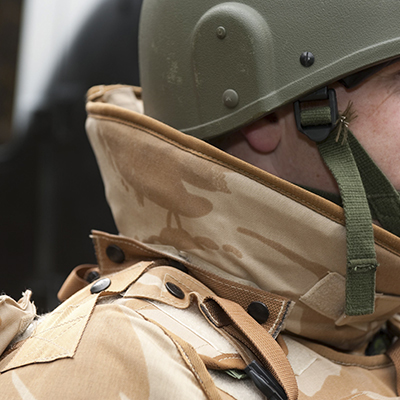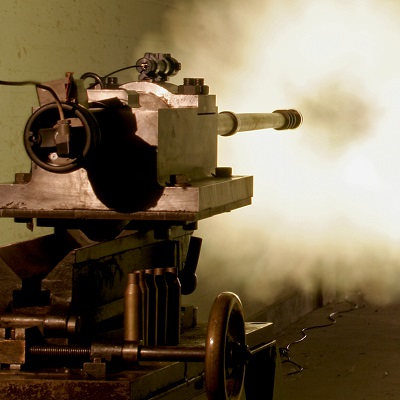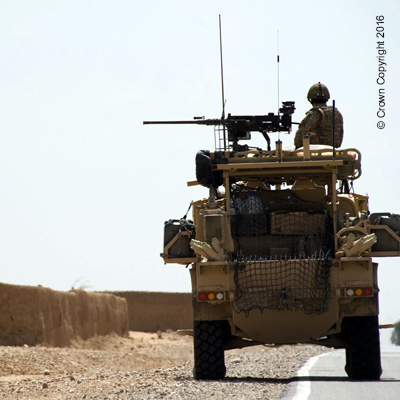The Group covers teaching and research into two interrelated NATO domains of Survivability and Lethality, which are both underpinned from a technical perspective by Materials Science and Ballistics, along with Mechanics and Dynamics.
Part of the Centre for Defence Engineering, the Lethality and Survivability Group is run by Stephen Champion and focuses on the philosophy of Survivability and Lethality stemming from the underpinning knowledge of the supporting technologies and science of ballistics (internal, intermediate through external to terminal, including wound ballistics), dynamics of mechanisms and materials science, particularly at high strain rates as experienced by impact.
The group conducts research and consultancy on a wide range of topics for both MOD and civilian clients. In addition to several current PhD students, the Group also actively supports a wide cohort of MSc project students.
Professional development (CPD)
The academic background of the members means that the Lethality and Survivability Group is able to provide a wide range of academic services. The Group has a core focus on survivability of personnel, vehicles and aircraft. In particular, short courses linked to armour systems (such as armour system design) can be provided employing an extensive selection of low, medium and high strain-rate loading apparatus.
Furthermore, tailored courses focused on key aspects of high-rate loading (shock, detonics etc) can be readily provided with additional support readily available from key experts with Cranfield University.
Our research
The Group is highly research active with experts in a variety of physical, chemical and biological sciences spheres. Its capabilities allow impact loading from a few m/s (drop towers) through to 8 km/s (a two-stage powder-gas gun).
Current research projects include:
-
Panspermia: The Shock Response of Organic Structures as Models for Planetary Impact Survival
Key biomolecules are believed to be stable and are functional up to 200-300 GPa. Some organisms, however, are able to survive pressures which are a magnitude higher than this. We need to redefine the questions pertaining to the survival of life in extreme conditions and the mechanism(s) employed by these varied organisms. High strain-rate shock experiments reveal enhanced survival rates extending to higher pressures. Extrapolating this allows us to consider the implications of some organisms surviving bolide impacts thus allowing successful movement between planetary bodies. Further, such understanding of this survival is not only critical for the food sterilization industry and other preservation technologies, but, also for the implications for the survival of life under extreme compression conditions and its possible extent in the laboratory and throughout the universe.
- The High Strain-Rate and Shock Response of Porcine Tissues
Understanding the behaviour of tissues and their analogues under ballistic impact is of particular importance if we are to be able to predict - and ideally protect against - likely damage from a given threat. However, in real-world materials, biological elements (limbs etc) are complex, compromising more than a single material. Consequently, the Survivability, Lethality and Materials Group has an ongoing research programme supporting several MSc courses focused on understanding fundamental high strain-rate (impact-related) material properties for common tissue simulants in order to provide a database to allow for development of more physically realistic simulated tissue constructs for research processes.
-
Understanding Ceramic Armour
Ceramic armour is able to defeat incoming ballistic/quasi-hydrodynamic projectiles via the process of ‘dwell’ or ‘interface defeat’. Essentially, on impact the ceramic (chosen to be harder than the likely threat) is placed into compression and as long as this state remains the armour overmatches the incident projectile via flow at the outer surface. However, this phenomenon is very sensitive to tensile reflections from free (lower impedance) surfaces. The Survivability, Lethality and Materials Group has an ongoing interest in understanding how to optimise ceramic armour behaviour under high velocity impact and regular conducts MSc and other research projects in this field. In particular, focus on both the ceramic-metal interface and the potential of additively manufactured (AM) ceramics to provide novel constructs to aid in armour performance are being investigated as part of this ongoing programme.
- Shock Behaviour of Polymer Materials
- Normal and Oblique Penetration Studies in CFRP Laminates
- Lightweight Armour Optimisation Studies
- The Dynamic Behaviour of Tungsten Carbide
- Low Collateral Damage Explosive Reactive Armour
- Shock Processing for the Food Industry
- Dynamic Behaviour of Nano-reinforced Polymer Resins for Transparent Armour Applications
- Inducing Dwell in Ceramic-faced Armour Systems.
- The Hypervelocity Response of Composite Materials
There has been a significant move in the aerospace industry towards the exploitation of the high specific strength of composites - primarily driven by an ongoing requirement to reduce mass and therefore enhance efficiency. Such materials have been employed extensively both in aircraft and space-relevant structures. While a significant body of work exists on their impact response in the ballistic regime there is a relative paucity of information at hyper-velocities (>3km/s) corresponding to either re-entry or orbital speeds or even impact velocities of likely future weapons systems. Consequently, a series of ongoing student-driven research projects are being conducted to elucidate composite material response at such elevated velocities utilising the in-house two-stage powder-gas launcher.
Our facilities
The Lethality and Survivability Group offers a range of education, research and consultancy services within its areas of expertise.
The Group’s research facilities include numerous compressed and powder gas-guns/launchers, split Hopkinson pressure bar and accelerated instrumented drop towers which can be used for materials characterisation and impact testing. Together these allow precise application and measurement of dynamic loads all the way from quasi-static conditions to impact velocities of 8,000m/s. These experiments can provide materials property data for assessment and modelling purposes. In addition, the group has access to extensive ballistics facilities to allow assessment of protective solutions.
At the higher impact velocities, typical applications of the in-house launchers include: derivation of material Hugoniot equations-of-state; investigation of material (armour and other) failure modes under ballistic or high velocity impact, e.g. dynamic tensile failure/spall, shear, etc; hail impact simulation; blast debris analysis; and low-velocity fragment hazards assessment.
Our facilities include:
- 2 no. 50mm bore single-stage guns;
- 75mm bore pressure-shear gun;
- 22mm and 30mm bore single-stage ballistic guns plus 10-mm vertical/inclined-impact gas-gun;
- Powder-gas two-stage gun able to fire small-scale projectiles up-to 8km/s;
- Compressive and tensile/torsional sHpbs;
- Numerous additional low-medium velocity gas-driven launchers;
- Instrumented (bungie accelerated) drop towers plus knife stab rig;
- Shock tube;
Available diagnostics range from high speed cameras (including a digital speckle interferometry capability) through both strain and stress gauges (both longitudinal and lateral) as well as multiple Hetrogenous-velocimetry (Het-v) channels as well as multiple channels of flash X-ray.



